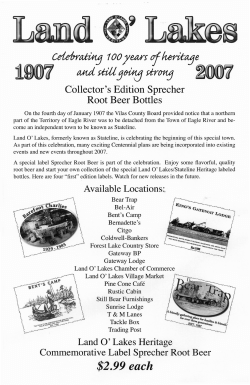
The temporal mapping of water bodies from the perspective of
Land_Cover_CCI The Temporal Mapping of Water Bodies from the Perspective of Climate Modelling Stefan Hagemann1, Tobias Stacke1, Goran Georgievski1, Philippe Peylin2, Catherine Ottlé, Malcolm Brooks3, Andrew Hartley3 1Max Planck Institute for Meteorology 2Laboratoire des Sciences du Climat et de l’Environnement 3MetOffice Hadley Centre Overview Importance of surface water bodies in climate modelling and NWP forecasts Modelling surface water bodies and evaluation of results Thermokarst lakes Conclusions MWBS conference: Frascati, 18 March 2015, Stefan Hagemann Importance of modeling water bodies in climate models Water bodies = lakes, reservoirs, rivers.. Play a key role on regional and global water and energy cycles because of their different spectral/thermal/energy properties: albedo, heat capacity, roughness, … Impact heat and water fluxes into the atmosphere but also carbon and methane fluxes… (e.g. boreal wetlands…) Impact water discharges and water resources (role of reservoirs on flood control, irrigation supply and water diversion ; role of lake temperature on water quality, fish and aquatic life, etc… ) Feedbacks on regional and global climates through atmospheric coupling MWBS conference: Frascati, 18 March 2015, Stefan Hagemann Soil Moisture/Surface Water Feedbacks Soil Moisture – Precipitation Soil Moisture decrease Precipitation decrease Less moisture recycling Soil Moisture – Temperature Evapotranspiration decrease Soil moisture decrease Evapotranspiration decrease Temperature increase MWBS conference: Frascati, 18 March 2015, Stefan Hagemann Seasonal Water Bodies for NWP Forecasts of dust • More accurate and seasonal water body extent is needed for NWP simulation of dust storms • Static land cover is inadequate to describe these highly dynamic environments • Why is dust important? • Depending on level of atmosphere, dust can have a cooling or warming effect • Can affect regional precipitation • Dust storms impact on human health and transport infrastructure, especially aviation © Crown copyright Met Office Operational forecast model • Data Assimilation of MODIS Aerosol Optical Depth • Produces best possible description of atmospheric dust at current time (T+0) Dust AOD at 550nm at T+0 (time mean for 19/06/2014 to 28/06/2014) © Crown copyright Met Office Operational forecast model ... But 5 days later (T+120), there are large negative anomalies of dust over the Aral Sea. Dust AOD atDust 550nm AODatatT+120 550nm Anomaly at T+120 vs Reanalysis (time (time mean meanfor for 19/06/2014 19/06/2014to to 28/06/2014) 28/06/2014) © Crown copyright Met Office Case Study: aviation impact On 20th December 2011, Prime Minister David Cameron made a surprise visit to British Forces in Afghanistan. The visit was disrupted by a large dust storm (a). Forecasts produced only a weak, small scale event (b). Cause of error was poor representation of dry lake beds. © Crown copyright Met Office ORCHIDEE (Land part of the IPSL-LMD-Z climate model) A mosaic of vegetation 13 Plant Functional Types Complex description of the vegetation processes but no explicit treatment of water bodies! Preliminary developments in permafrost regions: the representation of thermokarst lakes and related emissions of CH4 and CO2 (Peng et al., in preparation) MWBS conference: Frascati, 18 March 2015, Stefan Hagemann MPI-M: WEED scheme Wetland water balance Equilibrium approach MPI-HM implementation: Stacke & Hagemann (2012) HESS. JSBACH Goran Georgievski’ s presentation. MWBS conference: Frascati, 18 March 2015, Stefan Hagemann Various water body & wetland data MWBS conference: Frascati, 18 March 2015, Stefan Hagemann The validation problem Large uncertainty between datasets complicates validation and model optimization Only at few locations observation data on lake level variations are available for the validation of lake dynamics Stacke & Hagemann (2012) MWBS conference: Frascati, 18 March 2015, Stefan Hagemann MPI-HM: Seasonal variations Seasonal deviations from mean wetland extent DJF MAM JJA SON MWBS conference: Frascati, 18 March 2015, Stefan Hagemann Thermokarst Melt of segregated ice and ice wedges G. Hugelius http://en.wikipedia.org/ wiki/Pingo MWBS conference: Frascati, 18 March 2015, Stefan Hagemann Thermokarst Impact of disturbance on surface heat balance Increase of active layer thickness Permafrost degradation Melt of segregated ice Soil subsidence Water accumulation Change of surface heat balance MWBS conference: Frascati, 18 March 2015, Stefan Hagemann Thermokarst lakes are important for climate change Represent large fraction of lakes in high latitudes Rapid changes observed : decrease in discontinuous permafrost areas by increased drainage… 1973 Link with dynamic of ice wedges 1997 MWBS conference: Frascati, 18 March 2015, Stefan Hagemann Smith et al., 2005, Science; Picture from Walter et al., 2014, Nature Thermokarst JSBACH Simplified biophysical model with annual timestep Ph. D. thesis T. Schöngassner MWBS conference: Frascati, 18 March 2015, Stefan Hagemann Modeling of thermokarst lakes in ORCHIDEE : Added processes Algorithm: THAW lakes Local water balance from precipitation and ET, runoff (LWB) Temperature (T) Ground ice modeling (prescribed initial cover) Temperature increase Permafrost Grid N N Y Continuous permafrost ice content > threshold Y ΔTLA =Lthermal+Lwind+Lwater +Drainage_con N Thaw lake area (TLA) > threshold “Seedling” of small water bodies Y ΔTLA = Drainage_discon TLAt+1 = TLAt + ΔTLA Temperature Labile carbon (SOCL) CH4 flux density = SOCL * R0 * Q10^(T-Tref) Flake model (Mironov 2008) Lake temperature profile Ice melting CH4 emission = CH4 flux density * TLA Methane Emissions ORC Soil Organic Carbon Lake lateral expansion from - thermal erosion (from ice melt) - wind erosion - local water balance - drainage (Peng et al., in prep. ) Foreseen developments in ORCHIDEE Crops Representation of a water fraction in the grid (separate lakes and rivers) Managed grass Separate energy balance and surface temperature Bare soil / desert Forest Water bodies Natural grass Surface area set with satellite products. lake/river depths defined with available databases Calibration with remote sensing products (surface temperature from IRT data, water level variations from altimetry, water surface extent, albedo, evaporation, etc…) Data required Water bodies maps : discrimination between lakes and rivers Seasonal and interannual variations Spatial and temporal coherence of WB with Lcover, Surf. Temp, Albedo Surface water body requirements Spatial mapping • Spatial distribution at high resolution with uncertainty information • Temporal changes on monthly or higher resolution • Mapping of extends e.g. floodplains/events even for vegetation covered areas (e.g. Amazon Basin) Additional information • Time series of water depth with uncertainty information • Freezing events • Surface water body temperature • Distinction between lakes and wetlands Thank you for your attention! • Long-term monitoring of changing landscape characteristics, e.g. thermokarst lakes Annual states with high spatial resolution MWBS conference: Frascati, 18 March 2015, Stefan Hagemann CT: From tundra climate to taiga Steps of Transition: o Dry ice-rich continuous permafrost o Warming of soil surface o Melt of segregated ice o Water accumulation at the surface o Further permafrost thawing o Moist sporadic permafrost o Development of swamps and boreal forests MWBS conference: Frascati, 18 March 2015, Stefan Hagemann Surface water bodies Surface water bodies include wetlands Anoxic decomposition produces methane Increase in wetlands area more methane production Scientific questions How the distribution of surface water bodies is affected by climate change conditions? How does a change their extend impacts the local and regional climate? Dynamic modelling required: e.g. Stacke & Hagemann (2012) HESS. MWBS conference: Frascati, 18 March 2015, Stefan Hagemann
© Copyright 2025










